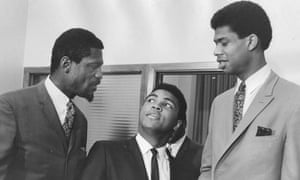In 1967, athletes put their weight behind Muhammad Ali after he refused to be drafted. Fifty years later, NFL players are again taking a political stand

In 1962, as a cornerback for the American Football Leagues Boston Patriots, Walter Beach rallied his fellow black players there were about five for a discussion.
The topic was what to do about a forthcoming exhibition game against the Houston Oilers that was scheduled to be played in New Orleans. As was custom and law in most of the south at the time, the team accommodations were to be segregated. Promoters planned to house the black players from both teams at a black-owned motel, and white players from both teams at a hotel two miles away. We were all in agreement that we didnt want to participate in it, Beach said.
The players, led by Beach, asked the team to simply allow them to fly down and fly back the day of the match rather than submit to the indignities of Jim Crow the name given to the laws enacted by southern states to legally enforce segregation after the civil war.
The team did buy Beach a plane ticket, he recalled: a ticket home. He was cut.
Five years later, retired, he found himself back at the intersection of activism and athletics. The boxing heavyweight champion of the world, Muhammad Ali, was facing intense public backlash, not to mention the possibility of jail time and having his titles stripped, over his refusal to be drafted for the Vietnam war.

In the midst of that uproar, the Cleveland Browns running back Jim Brown, who had just retired as the NFLs leading rusher, decided to call Ali and other prominent, vocal black athletes to a meeting. Beach, who had become close with Brown during their time together on the Browns, was invited to attend. None of us had any idea of trying to change Alis mind. The meeting was there to support his position, Beach said.
The meeting was held at the offices of the Negro Industrial Economic Union, a black empowerment organization that Brown himself had founded and had branches in other major US black hubs. After the meeting, which included a number of prominent athletes such as the Boston Celtics Bill Russell, the UCLA center Lewis Alcindor (who would later change his name to Kareem Abdul-Jabbar) and the Washington running back Bobby Mitchell a celebrated picture (at top) was snapped by journalists, as the stars put their weight behind Ali. Also invited, and pictured, was the Cleveland attorney Carl Stokes, who later that year would become mayor of the city the first black man to be elected to that office any major US city.
I felt with Ali taking the position he was taking, and with him losing the crown, and with the government coming at him with everything they had, that we as a body of prominent athletes could get the truth and stand behind Ali and give him the necessary support, Brown told the Cleveland Plain Dealer in 2012.
Now, just over 50 years after the meeting, which came to be known as the Muhammad Ali summit, its hard to ignore the parallels with the sudden resurgence of solidarity over social issues among black athletes. After a long chill from the 1980s through the 2000s, a number of factors, including Black Lives Matter and the protest movement authored by Colin Kaepernick, have brought that attitude roaring back.
Shut up and play football

Not all the athletes gathered necessarily shared Alis feelings about Vietnam or would have done the same in his shoes. In fact, reports from the meeting suggest the discussion several times became heated and emotional. What they all wanted to reinforce when it was over, though, was that black athletes had the right to use their profile to speak up and speak out, and shouldnt be limited to their exploits on the court or the field or in the ring.
It was very important that you let people understand that youre more than a football player. Football is what I did, it wasnt who I was. Muhammad Ali was a boxer. Thats what he did. That wasnt who he was, Beach said.
Cue up to the present, and athletes are rejecting that compartmentalizing from fans all over again. People told me to shut up and play football, the Cleveland Browns wide receiverAndrew Hawkins told Slate in 2016. But what they dont realize is [these issues are] more important to me than what anybodys public perception of me is when I give my opinion.
Hawkins was one of the players who triggered the new wave of athlete protests, which predated Kaepernicks campaign, by wearing a shirt over his game jersey in 2014 that demanded justice for Tamir Rice and John Crawford, both black males shot by police while holding toy guns. Even before that, in 2012, the Miami Heat took a team photo in black hoodies as a tribute to the Florida teenager Trayvon Martin, an unprecedented move at the time.
But none of these Black Lives Matter inspired-efforts by athletes carried quite the same impact as what Colin Kaepernick, the former San Francisco 49ers quarterback, started in August 2016 when he began sitting, and then kneeling, for the national anthem in protest against police violence. Kaepernicks actions spurred the same type of vitriol and the same wave of solidarity that Ali generated all those years ago.
There hasnt been a moment where youve had a photo op that came to that, where you have had a photo of Colin Kaepernick surrounded by LeBron James and Michael and Martellus Bennett, Gregg Popovich and so on, but de facto youve had the same thing, said the Columbia Journalism School professor Samuel Freedman. Theres really been a rallying around [Kaepernick].
The rallying, timid at first, peaked after Kaepernick became the object of Donald Trumps abuse late last month, when Trump, without naming him, suggested the quarterback was a son of a bitch at an Alabama rally for his refusal to stand for the national anthem. It was a popular sentiment with the Trump supporters in attendance, and with white Americans in general, according to polling.
But Trumps ire only managed to make the protests more popular. Increasingly, the kneeling protests have become adopted not just in the NFL, but among various soccer clubs, the WNBA, and youth sports teams, all while Kaepernick remains apparently toxic to NFL owners and the GMs who decide which players make the roster.
Thus, the once (briefly) best-paid QB in the NFL has become equal parts folk hero and pariah in much the same way Ali polarized Americans during the 1960s. Kaepernick is the only player currently, and maybe ever, to have jersey sales in the leagues top 40 while not even signed to a team. Indeed, his jersey has come to be more associated with black consciousness and activism than football, with many non-fans of his former team, or even the game, seeking it out, mirroring a broader trend among his overall fanbase.
A courageous, prophetic, self-sacrificial act

In 1962, the season after his unceremonious dismissal from the Patriots, Beach caught on with the Cleveland Browns where he met Brown and he said his experience was much the same. He said the team held him for years in a sort of roster limbo: placing him on waivers, which would allow another team to sign him, and then retracting the waivers when another team tried to.
Beach is convinced this roster trickery was intended to achieve one purpose alone. I was a liability. I was one of those individuals that struggled against racism all the time. They wanted to blackball me and thats precisely what they doing to Kaepernick.
Kaepernick filed suit against the NFL earlier this week, accusing the leagues owners of colluding to deny him employment due to his polarizing demonstration.
Beach also sued. And won. He had years of service added to his pension on the grounds that, had the team allowed him to sign on elsewhere, he could have played longer.
But what remains to be seen is whether the energy that players have collected in the Trump era can translate into something as unified in message as the Ali Summit, or even more. If it does, players like Kaepernick may never have to worry about whether their vocal stances on social issues will leave them unemployed.
I think the symbolic points been made, and I think the open question is what the players do with the social power that theyve achieved, said Freedman, who wrote the book Breaking the Line, about the intersection of college football and the civil rights movement.
Last week, the Los Angeles Chargers tackle Russell Okung proposed essentially a 21st-century summit, allowing players to unite behind a single narrative.
I am convinced that we will never make progress if we do not find a way to come together and take action that represents the will of the players, he wrote in an open letter to his colleagues.
As Kaps message has now been distorted, co-opted and used to further divide us along the very racial lines he was highlighting, we as players have a responsibility to come together and respond collectively.
Okung said he had initially been skeptical of Kaepernicks tactics but wrote: There is now no doubt in my mind that what he did last season was a courageous, prophetic, self-sacrificial act that has captivated a nation and inspired a powerful movement.
If I had his cellphone number, I would tell him that.
If what hes proposing comes to fruition, and if history is any guide, maybe hell get to tell him in person instead.
Read more: https://www.theguardian.com/sport/2017/oct/23/colin-kaepernick-muhammad-ali-summit-sports-activism












You must be logged in to post a comment.